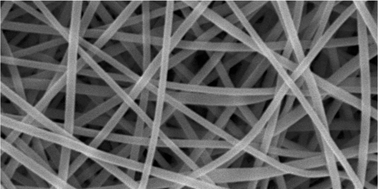Solution chemistry control to make well defined submicron continuous fibres by electrospinning: the (CH3CH2CH2O)4Ti/AcOH/poly(N-vinylpyrrolidone) system
Abstract
The (CH3CH2CH2O)4Ti/AcOH/poly(N-vinylpyrrolidone) system has been shown to yield suitable formulations for electrohydrodynamic (EHD) processing into continuous fibres and particles. The EHD processability of this, and generally most sol–gel-based formulations, into well defined fibres and particles with narrow submicron-range diameter distributions depends not only on the EHD process variables (electric field and flow rates), but also on the stability of key physical properties (e.g., conductivity, viscosity, surface tension, density and dielectric constant) of the sol over time. Sols that were almost certainly still undergoing hydrolysis and condensation reactions have been processed via EHD by many research groups to make materials with submicron features. This paper thus highlights the need for understanding the chemistry of EHD-processed solutions to afford reproducibility and near monodispersity in fibre diameter. Reactions were monitored over time with the aid of a flow-through infrared cell, and the structure of species in solution is discussed. Conductivity and viscosity changes with time of representative formulations are discussed in the light of typical EHD processing time scales. Representative sols were processed via EHD, and woven and non-woven fibrous mats were characterized by scanning electron microscopy (SEM).


 Please wait while we load your content...
Please wait while we load your content...